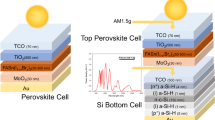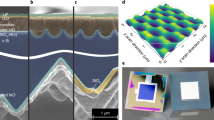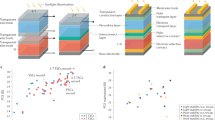Abstract
Two-terminal monolithic perovskite/silicon tandem solar cells demonstrate huge advantages in power conversion efficiency compared with their respective single-junction counterparts1,2. However, suppressing interfacial recombination at the wide-bandgap perovskite/electron transport layer interface, without compromising its superior charge transport performance, remains a substantial challenge for perovskite/silicon tandem cells3,4. By exploiting the nanoscale discretely distributed lithium fluoride ultrathin layer followed by an additional deposition of diammonium diiodide molecule, we have devised a bilayer-intertwined passivation strategy that combines efficient electron extraction with further suppression of non-radiative recombination. We constructed perovskite/silicon tandem devices on a double-textured Czochralski-based silicon heterojunction cell, which featured a mildly textured front surface and a heavily textured rear surface, leading to simultaneously enhanced photocurrent and uncompromised rear passivation. The resulting perovskite/silicon tandem achieved an independently certified stabilized power conversion efficiency of 33.89%, accompanied by an impressive fill factor of 83.0% and an open-circuit voltage of nearly 1.97 V. To the best of our knowledge, this represents the first reported certified efficiency of a two-junction tandem solar cell exceeding the single-junction Shockley–Queisser limit of 33.7%.
This is a preview of subscription content, access via your institution
Access options
Access Nature and 54 other Nature Portfolio journals
Get Nature+, our best-value online-access subscription
$32.99 / 30 days
cancel any time
Subscribe to this journal
Receive 51 print issues and online access
$199.00 per year
only $3.90 per issue
Buy this article
- Purchase on SpringerLink
- Instant access to full article PDF
Prices may be subject to local taxes which are calculated during checkout




Similar content being viewed by others
Data availability
The data that support the findings of this study are available from the corresponding authors upon reasonable request.
References
Aydin, E. et al. Pathways toward commercial perovskite/silicon tandem photovoltaics. Science 383, eadh3849 (2024).
Shi, Y., Berry, J. J. & Zhang, F. Perovskite/silicon tandem solar cells: insights and outlooks. ACS Energy Lett. 9, 1305–1330 (2024).
Al-Ashouri, A. et al. Monolithic perovskite/silicon tandem solar cell with >29% efficiency by enhanced hole extraction. Science 370, 1300–1309 (2020).
Chen, H. et al. Improved charge extraction in inverted perovskite solar cells with dual-site-binding ligands. Science 384, 189–193 (2024).
Wu, H. et al. Silicon heterojunction back contact solar cells by laser patterning. Nature https://doi.org/10.1038/s41586-024-08110-8 (2024).
NREL. Best research-cell efficiency chart. Photovoltaic Research; https://www.nrel.gov/pv/cell-efficiency.html (accessed 02 September 2024).
Niewelt, T. et al. Reassessment of the intrinsic bulk recombination in crystalline silicon. Sol. Energy Mater. Sol. Cells 235, 111467 (2022).
Long, W. et al. On the limiting efficiency for silicon heterojunction solar cells. Sol. Energy Mater. Sol. Cells 231, 111291 (2021).
Liu, W. et al. Light-induced activation of boron doping in hydrogenated amorphous silicon for over 25% efficiency silicon solar cells. Nat. Energy 7, 427–437 (2022).
Aydin, E. et al. Enhanced optoelectronic coupling for perovskite/silicon tandem solar cells. Nature 623, 732–738 (2023).
Chin, X. Y. et al. Interface passivation for 31.25%-efficient perovskite/silicon tandem solar cells. Science 381, 59–63 (2023).
Mariotti, S. et al. Interface engineering for high-performance, triple-halide perovskite-silicon tandem solar cells. Science 381, 63–69 (2023).
Aydin, E. et al. Ligand-bridged charge extraction and enhanced quantum efficiency enable efficient n–i–p perovskite/silicon tandem solar cells. Energy Environ. Sci. 14, 4377–4390 (2021).
Xu, L. et al. Monolithic perovskite/silicon tandem photovoltaics with minimized cell-to-module losses by refractive-index engineering. ACS Energy Lett. 7, 2370–2372 (2022).
Mazzarella, L. et al. Infrared light management using a nanocrystalline silicon oxide interlayer in monolithic perovskite/silicon heterojunction tandem solar cells with efficiency above 25%. Adv. Energy Mater. 9, 1803241 (2019).
Hou, Y. et al. Efficient tandem solar cells with solution-processed perovskite on textured crystalline silicon. Science 367, 1135–1140 (2020).
Chen, B. et al. Blade-coated perovskites on textured silicon for 26%-efficient monolithic perovskite/silicon tandem solar cells. Joule 4, 850–864 (2020).
Liu, J. et al. 28.2%-efficient, outdoor-stable perovskite/silicon tandem solar cell. Joule 5, 3169–3186 (2021).
Stolterfoht, M. et al. The impact of energy alignment and interfacial recombination on the internal and external open-circuit voltage of perovskite solar cells. Energy Environ. Sci. 12, 2778–2788 (2019).
Wang, J. et al. Reducing surface recombination velocities at the electrical contacts will improve perovskite photovoltaics. ACS Energy Lett. 4, 222–227 (2018).
Caprioglio, P. et al. Open-circuit and short-circuit loss management in wide-gap perovskite p-i-n solar cells. Nat. Commun. 14, 932 (2023).
Stolterfoht, M. et al. Visualization and suppression of interfacial recombination for high-efficiency large-area pin perovskite solar cells. Nat. Energy 3, 847–854 (2018).
Liu, J. et al. Efficient and stable perovskite-silicon tandem solar cells through contact displacement by MgFx. Science 377, 302–306 (2022).
Peña-Camargo, F. et al. Halide segregation versus interfacial recombination in bromide-rich wide-gap perovskite solar cells. ACS Energy Lett. 5, 2728–2736 (2020).
Li, Z. et al. Organometallic-functionalized interfaces for highly efficient inverted perovskite solar cells. Science 376, 416–420 (2022).
Li, F. et al. Regulating surface termination for efficient inverted perovskite solar cells with greater than 23% efficiency. J. Am. Chem. Soc. 142, 20134–20142 (2020).
Chen, H. et al. Regulating surface potential maximizes voltage in all-perovskite tandems. Nature 613, 676–681 (2023).
Zhang, F. et al. Metastable Dion-Jacobson 2D structure enables efficient and stable perovskite solar cells. Science 375, 71–76 (2022).
Chen, H. et al. Quantum-size-tuned heterostructures enable efficient and stable inverted perovskite solar cells. Nat. Photon. 16, 352–358 (2022).
Park, S. M. et al. Engineering ligand reactivity enables high-temperature operation of stable perovskite solar cells. Science 381, 209–215 (2023).
Azmi, R. et al. Damp heat-stable perovskite solar cells with tailored-dimensionality 2D/3D heterojunctions. Science 376, 73–77 (2022).
Menzel, D. et al. Field effect passivation in perovskite solar cells by a LiF interlayer. Adv. Energy Mater. 12, 2201109 (2022).
Richter, A. et al. Design rules for high-efficiency both-sides-contacted silicon solar cells with balanced charge carrier transport and recombination losses. Nat. Energy 6, 429–438 (2021).
Liu, W. et al. Flexible solar cells based on foldable silicon wafers with blunted edges. Nature 617, 717–723 (2023).
Peng, J. et al. Nanoscale localized contacts for high fill factors in polymer-passivated perovskite solar cells. Science 371, 390–395 (2021).
Adhyaksa, G. W. P., Johlin, E. & Garnett, E. C. Nanoscale back contact perovskite solar cell design for improved tandem efficiency. Nano Lett. 17, 5206–5212 (2017).
Mao, K. et al. Unveiling and balancing the passivation‐transport trade‐off in perovskite solar cells with double‐side patterned insulator contacts. Adv. Energy Mater. 13, 2302132 (2023).
Guillemoles, J.-F., Kirchartz, T., Cahen, D. & Rau, U. Guide for the perplexed to the Shockley–Queisser model for solar cells. Nat. Photon. 13, 501–505 (2019).
Cai, M. et al. Control of electrical potential distribution for high-performance perovskite solar cells. Joule 2, 296–306 (2018).
Jiang, C.-S. et al. Carrier separation and transport in perovskite solar cells studied by nanometre-scale profiling of electrical potential. Nat. Commun. 6, 8397 (2015).
Turkay, D. et al. Synergetic substrate and additive engineering for over 30%-efficient perovskite-Si tandem solar cells. Joule https://doi.org/10.1016/j.joule.2024.04.015 (2024).
Juarez-Perez, E. J. et al. Photodecomposition and thermal decomposition in methylammonium halide lead perovskites and inferred design principles to increase photovoltaic device stability. J. Mater. Chem. A 6, 9604–9612 (2018).
Rühle, S. Tabulated values of the Shockley–Queisser limit for single junction solar cells. Sol. Energy 130, 139–147 (2016).
Grimme, S., Hansen, A., Brandenburg, J. G. & Bannwarth, C. Dispersion-corrected mean-field electronic structure methods. Chem. Rev. 116, 5105–5154 (2016).
Acknowledgements
This work was supported by LONGi Central R&D Institute, the National Key Research and Development Program of China (no. 2023YFB4202505); Two-chain Integration Key Program of Shaanxi Province (no. 2023-LL-QY-16); the National Natural Science Foundation of China (no. 51821002); the Collaborative Innovation Center of Suzhou Nano Science & Technology, Key Basic Research Program of Jiangsu Province (no. BK20243031); the Soochow University (nos. NH16000124 and SR16000123); the Hong Kong Polytechnic University (no. P0042930); and the Research Grants Council of the Hong Kong Special Administrative Region, China (nos. PolyU 25300823 and PolyU 15300724).
Author information
Authors and Affiliations
Contributions
Jiang Liu, Y.H., L.D. and H.Z. conceived this work and designed the experiment. Jiang Liu, H.Z. and Qiaoyan Li acquired the PL spectra. J. Yu conducted the ToF-SIMS measurements. T.W.L. and J. Yin conducted the DFT calculations. Minghui Li and C.X. performed the KPFM measurements. Jiang Liu, Y.H. and L.D. designed the texture structure and contributed to its development. Y.H., L.D., H.Z., L.J., Y.Q., X.G, F.Z, Qibo Li, Y.Y., S.Z., X.W., Jie Liu, T.L., Y.G., Y.W. and X.D. fabricated and optimized the perovskite/silicon tandem solar cells. H.C., P.L., T.Z., M.Y., X.R., F.P., S.Y., M.Q., P.X., Z.Z. and Menglei Li fabricated and optimized the silicon bottom cells. P.G. conducted the XPS and UPS measurements. Jiang Liu and Y.H. wrote the draft of the manuscript. Jiang Liu, Y.H., L.D., B.H. and X.X. reviewed and polished the manuscript. C.X., P.X., H.Y., J. Yin, X.Z., Z.L., B.H. and X.X. supervised the project and secured the funding.
Corresponding authors
Ethics declarations
Competing interests
A patent application (No. 202310730135.2, filed in China) that covers the asymmetrically sized texturing used in this work has been submitted.
Peer review
Peer review information
Nature thanks Marko Mladenovic and the other, anonymous, reviewer(s) for their contribution to the peer review of this work.
Additional information
Publisher’s note Springer Nature remains neutral with regard to jurisdictional claims in published maps and institutional affiliations.
Supplementary information
Supplementary Information
Supplementary Notes 1–4, Figs. 1–31 and references.
Rights and permissions
Springer Nature or its licensor (e.g. a society or other partner) holds exclusive rights to this article under a publishing agreement with the author(s) or other rightsholder(s); author self-archiving of the accepted manuscript version of this article is solely governed by the terms of such publishing agreement and applicable law.
About this article
Cite this article
Liu, J., He, Y., Ding, L. et al. Perovskite/silicon tandem solar cells with bilayer interface passivation . Nature 635, 596–603 (2024). https://doi.org/10.1038/s41586-024-07997-7
Received:
Accepted:
Published:
Issue date:
DOI: https://doi.org/10.1038/s41586-024-07997-7
This article is cited by
-
Monolithic Perovskite/Perovskite/Silicon Triple-Junction Solar Cells: Fundamentals, Progress, and Prospects
Nano-Micro Letters (2026)
-
Sacrificial layer concept interface engineering for robust, lossless monolithic integration of perovskite/Si tandem solar cells yielding high fill factor of 0.813
Nano Convergence (2025)
-
Balancing aesthetics and efficiency of coloured opaque photovoltaics
Nature Reviews Clean Technology (2025)
-
Light detectors made from perovskite crystals see in full colour
Nature (2025)
-
Total X-ray scattering and big-box modeling of pressure-induced local disorder and partial amorphization in CsPbBr3
Nature Communications (2025)



